22 Trees With Heart Shaped Leaves
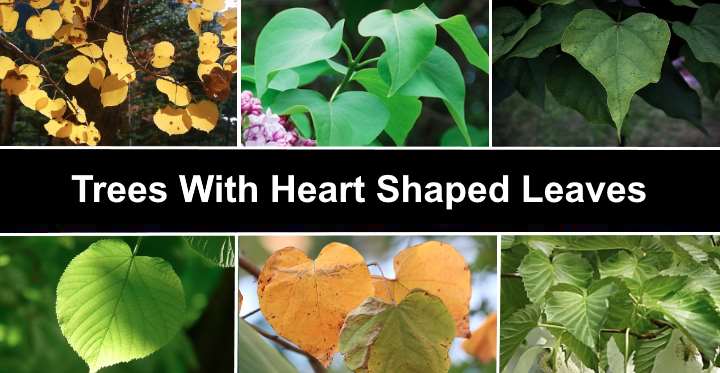
Trees with heart-shaped leaves can be beautiful additions to a garden landscape. Attractive trees like redbuds, lindens, and catalpas have leafy foliage shaped like hearts. These ornamental trees are aesthetically pleasing, bloom with fragrant flowers, and provide shade in gardens. The added beauty and symbolic meaning of heart-shaped leaves add to the trees’ appeal.
Leaf shape is one of the best ways to identify species of trees. They come in ovate, oblong, lanceolate, triangular, and palmate shapes. Tree leaves can have a simple arrangement or be compound leaves, with several smaller leaflets making a larger leaf. Of all the shapes of tree leaves, the ones in the shape of a heart are the most attractive.
This article describes various species of trees with heart-shaped leaves. You’ll learn how to identify these leafy wonders and if they would work in your garden landscape.
What are Trees with Heart-Shaped Leaves?
Many trees have leafy foliage resembling the traditional shape of a heart. The leaves are triangularly shaped with a rounded base, indented at the center. The other end of the leaf tapers to an apex. Heart-shaped tree leaves can be cordate or obcordate, depending on which end has the petiole.
- Cordate leaves: The petiole is attached to the indentation at the rounded base.
- Obcordate leaves: The petiole is attached to the pointed end of the heart-shaped leaf.
How to Identify Trees With Heart-Shaped Leaves
Identifying trees with heart-shaped leaves starts by observing the leaf’s overall shape. Most tree species with heart-shaped leaves have cordate leaves. Some have serrated margins, whereas others have smooth margins. Also, observe the base. Linden tree leaves have asymmetrical bases—uneven lobes. In contrast, redbud and catalpa trees have symmetrical bases.
In addition to looking at the distinctive heart shape of tree leaves, you can take note of other tree identification features. These identifying characteristics include the tree’s flowers, bloom time, overall shape, bark, and height.
Trees With Heart-Shaped Leaves — Pictures and Identification
Let’s look in more detail at various species of trees with leafy foliage resembling a typical heart shape.
Eastern Redbud (Cercis canadensis)
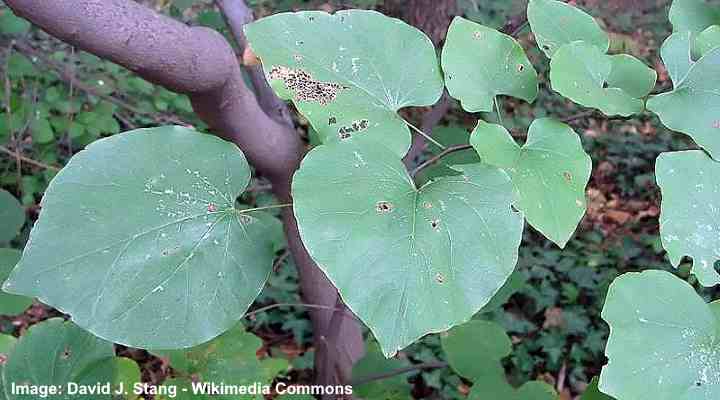
The eastern redbud tree is one of the most common deciduous trees with leaves in a heart shape. The multi-trunked tree features masses of stunning pink flowers. The small, pea-like pink flowers bloom in spring, covering the tree’s bare branches. Heart-shaped leaves appear in late spring and turn greenish-yellow in the fall.
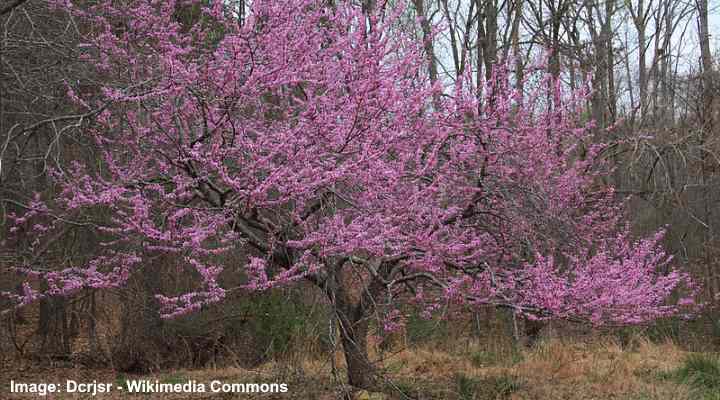
An eastern redbud tree
Eastern redbuds are ornamental trees growing up to 30 ft. (9 m) tall. Their pink, nectar-rich flowers attract pollinators in spring. In summer through winter, bean-like seed pods dangle gracefully from the branches. When the heart-shaped leaves drop, the tree’s attractive irregular branching stands out, creating a pretty silhouette.
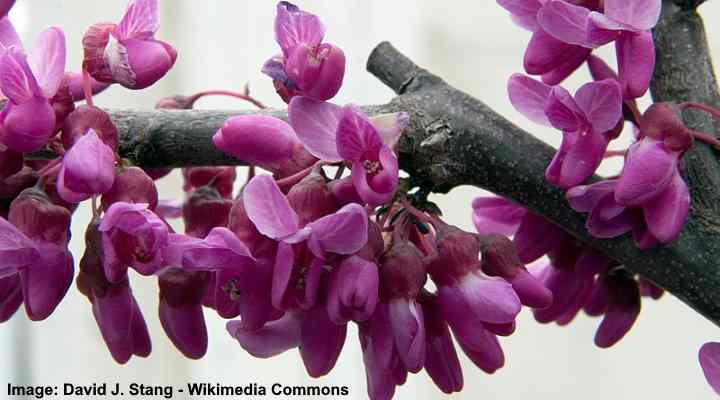
Eastern redbud flowers
Eastern redbud trees grow best in full sun and well-drained soils. However, they perform well in xeric to mesic landscapes. They are common in residential landscapes due to their beautiful blooms and unique foliage.
- USDA Hardiness Zones: 4 to 9
- Flower Color: Rosy-pink
- Light: Full sun to partial shade
- Mature Size: 20 to 30 ft. (6 – 9 m) tall and wide
Western Redbud (Cercis occidentalis)

The western redbud tree is a beautiful small tree with heart-shaped, apple-green leaves. The flowering tree blooms in early spring before the cordate leaves appear. Its flowers are pea-shaped, purple-pink and cover the contorted bare branches. The western redbud’s fall foliage colors are golden yellow to rusty red.
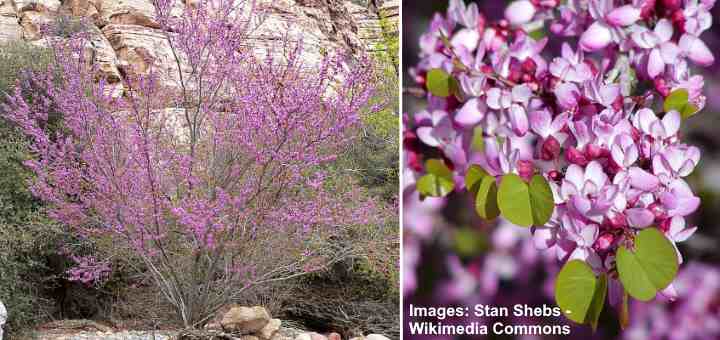
A western redbud tree and flowers
Western redbud trees typically grow up to 15 ft. (4.5 m) tall and wide. It is adorned with a rounded shape, smooth, silvery-gray bark, and stunning magenta flowers. In winter, the tree’s ornamental value is from its attractive shape and silvery bark. It’s drought-tolerant and thrives in most moist, well-drained soils.
This tree’s small size and adaptability make it ideal for landscaping small gardens. You can also train it to grow as a deciduous shrub to enjoy its vibrant spring blossoms and attractive heart-shaped foliage.
- USDA Hardiness Zones: 6 to 9
- Flower Color: Purple-pink or magenta
- Light: Full sun to partial shade
- Mature Size: 15 to 20 ft. (4.5 – 6 m) tall and wide
Weeping Redbud (Cercis canadensis ‘Lavender Twist’)

The weeping redbud ‘Lavender Twist’ cultivar has graceful weeping branches, attractive cordate leaves, and beautiful lavender-pink flowers. The cascading branches covered in deep pink, pea-sized flowers brighten spring landscapes. Its twisted trunk, contorted branching habit, heart-shaped leaves, and yellow fall colors give it aesthetic value for front or backyards.
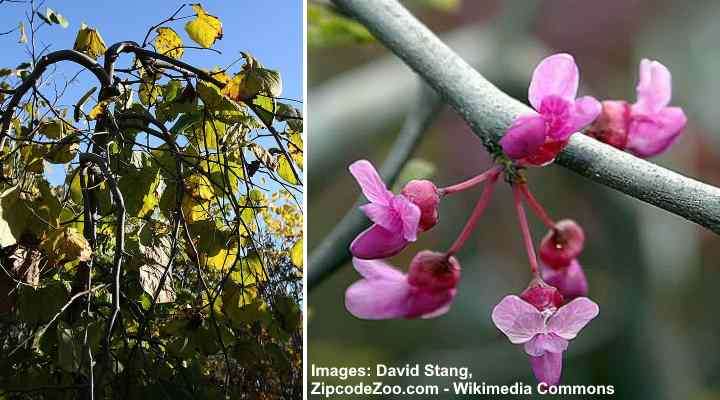
An eastern redbud ‘Lavender Twist’ tree and flowers
Weeping redbuds grow up to 6 ft. (1.8 m) tall. Their compact size makes them perfect for smaller gardens or limited spaces. It’s also an important tree for early pollinators, providing nectar in early spring before many trees have blossomed. Also, the golden yellow foliage adds a touch of autumn vibrancy.
- USDA Hardiness Zones: 4 to 9
- Flower Color: Lavender-pink
- Light: Full sun to partial shade
- Mature Size: 5 to 6 ft. (1.5 – 1.8 m) tall and 6 to 8 ft. (1.8 – 2.4 m) wide
Princess Tree (Paulownia tomentosa)

The princess tree is a fast-growing deciduous tree with large, heart-shaped leaves. The defining features of the tree are its huge leaves, which are 6” to 16” (15 – 40 cm) across, clusters of violet-purple flowers, and egg-shaped fruit capsules. Despite being native to China, the large shade tree has naturalized in North America.
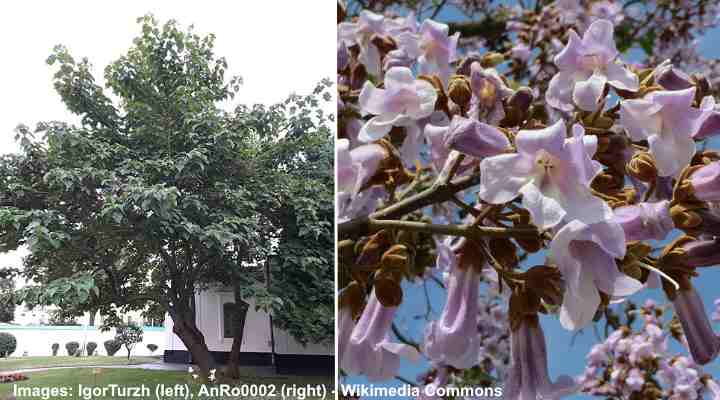
A royal empress tree and flowers
Princess trees grow up to 82 ft. (25 m) tall. They have a broad, spreading crown and a straight trunk. The bark is grayish-brown and becomes rough with age. It’s also a fast-growing tree that spreads easily through seeds. Princess trees can also tolerate pollution, making them suitable for urban environments.
Also called the foxglove tree or empress tree, the large tree with heart-shaped leaves is used as an ornamental tree in large parks. It also has good timber and helps to stabilize and restore soil.
- USDA Hardiness Zones: 5 to 9
- Flower Color: Lavender–purple
- Light: Full sun to partial shade
- Mature Size: 30 to 80 ft. (9 to 25 m) tall and wide
American Linden / Basswood (Tilia americana)
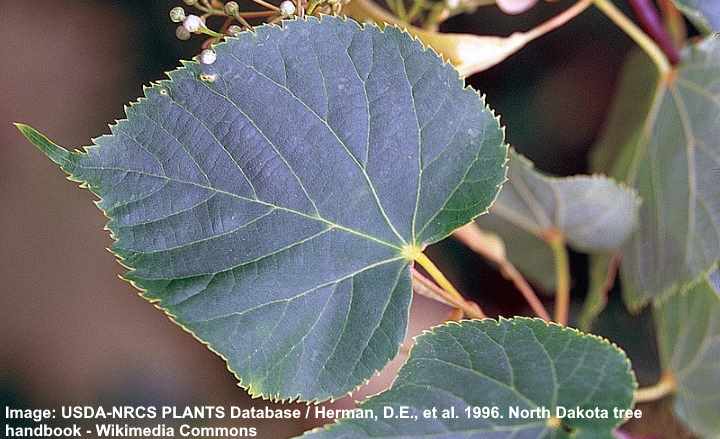
The American linden is a tall deciduous tree with simple, cordate leaves arranged alternately on branches. Also called the American basswood, this attractive tree is characterized by its clusters of fragrant, yellowish flowers, grayish-brown bark, and heart-shaped leaves. Linden tree leaves have an asymmetrical base—one lobe is larger than the other.
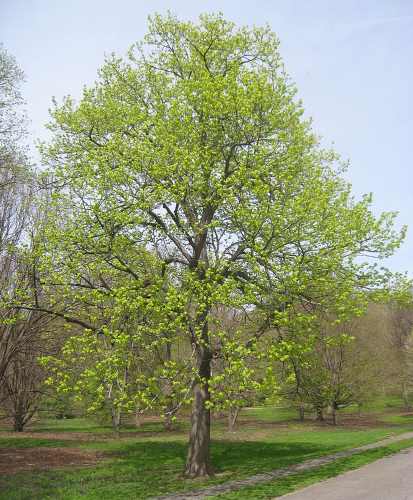
An American linden tree
The American linden tree can grow up to 120 ft. (37 m) tall and has a rounded to pyramidal crown. It’s a fast-growing tree with many benefits to wildlife. Its nectar-rich flowers attract bees, butterflies, and other pollinators. Its small, rounded, cream-colored nutlets are a food source for small mammals.
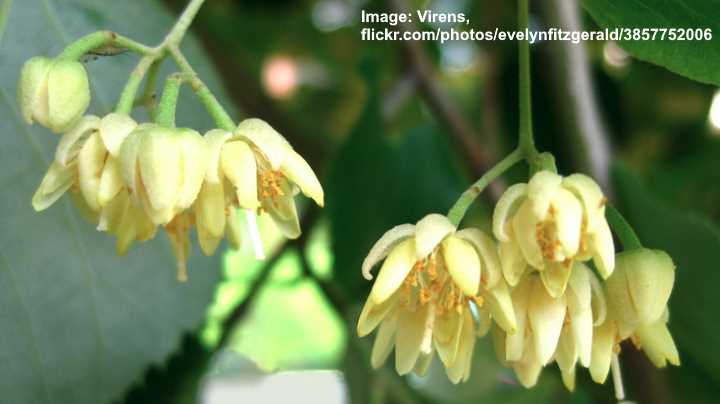
American linden flowers
The American linden tree has large heart-shaped leaves 4” to 6” (10 – 15 cm) long. However, some leaves can grow 10” (25 cm) long. In the fall, the cordate leaves turn a yellowish-green color. It’s a common landscaping shade tree in parks and residential areas.
- USDA Hardiness Zones: 2 to 8
- Flower Color: Creamy-yellow
- Light: Full sun to partial shade
- Mature Size: 50 to 80 ft. (15 – 24 m) tall and up to 50 ft. (15 m) wide
Silver Linden (Tilia tomentosa)

The silver linden tree has sharply toothed, heart-shaped leaves with silvery, fuzzy undersides. This large deciduous tree has a broadly pyramidal habit, green and silvery-white leaves, and fragrant, creamy-white flowers. The leaves give the tree a shimmering effect in even the slightest of breezes. It blooms in early to mid-summer.
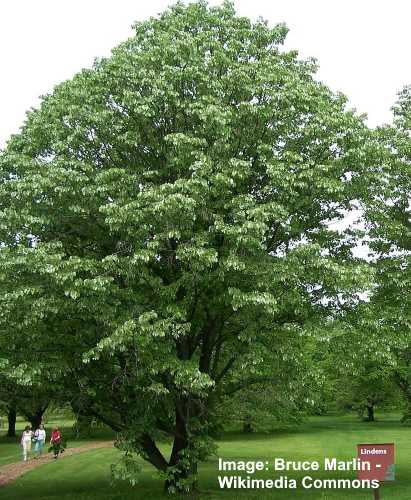
A silver linden tree
Silver linden trees can grow up to 70 feet (21 m). Their fragrant flowers attract bees in mid-summer, and their small nutlets are a good food source for squirrels and other small creatures. The cold-hardy trees tolerate drought and full sun and perform well in urban settings.
In addition to their visual appeal, silver linden trees provide shade in large gardens and parks. The flowers can also be used to make an herbal, caffeine-free tea.
- USDA Hardiness Zones: 4 to 7
- Flower Color: Yellow
- Light: Full sun to partial shade
- Mature Size: 50 to 70 ft. (15 to 21 m) tall and 30 to 50 ft. (9 to 152 m) wide
Henry’s Lime (Tilia henryana)

Henry’s lime tree is a medium-sized ornamental tree with heart-shaped green leaves featuring prominent yellow veins. The sea-green leaves have fringed margins with long teeth. Additional features include its drooping clusters of creamy-yellow flowers and showy nutlets that ripen by late summer. It also has a rounded crown.
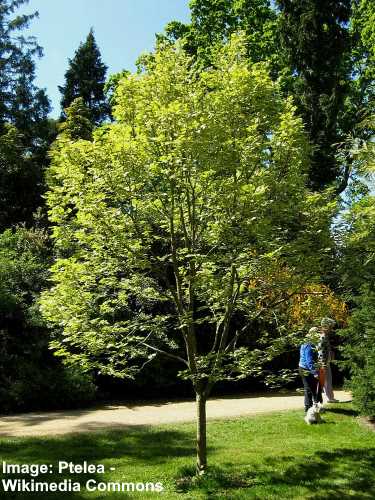
Henry’s lime tree
The heart-shaped fringed leaves emerge in spring in silvery-pink colors. These develop a soft, downy feel as they turn dark green. Henry’s lime trees grow up to 30 ft. (9 m) tall and wide. It has a pyramidal shape when young but matures into a more rounded form. The bark is smooth and grayish-brown, adding to its overall aesthetic value.
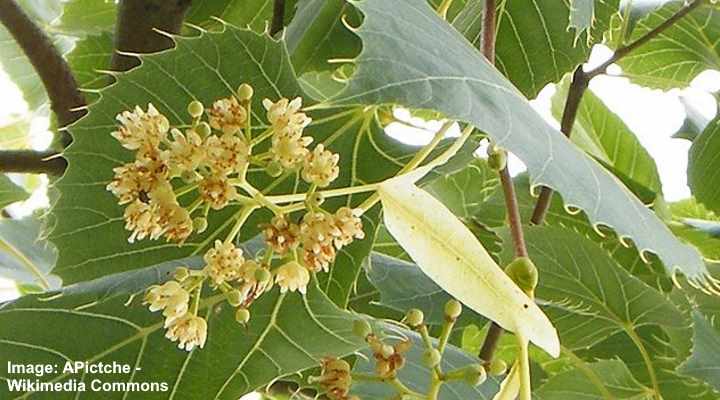
Henry’s lime tree flowers
Henry’s lime trees prefer full sun or partial shade and well-drained soil. They adapt to various soil types and can tolerate urban conditions. With its striking foliage and fragrant flowers, this tree adds beauty, shade, and interest to garden landscapes.
- USDA Hardiness Zones: 6 to 8
- Flower Color: Yellow
- Light: Full sun to partial shade
- Mature Size: 20 to 30 ft. (6 – 9 m) tall and wide
European Linden (Tilia europaea)

The European linden is identified by its dark green, heart-shaped leaves and showy clusters of creamy-white or yellowish flowers. This deciduous, ornamental tree blooms in early summer, filling landscapes with sweet fragrances. Its heart-shaped leaves grow up to 4” (10 cm) long. Its thin bark develops grooves as it matures.
Native to Europe, this Tilia species grows up to 70 ft. (21 m) tall. It’s an ornamental tree in parks and urban areas due to its attractive foliage, fragrant flowers, and tolerance to pollution. The canopy of heart-shaped, serrated leaves provides a dense canopy and shade in large landscapes.
In the fall, the leaves of the European Linden turn a vibrant golden yellow before eventually dropping. The tree’s fruits, known as nutlets, are small and round and provide food for birds and small mammals.
- USDA Hardiness Zones: 3 to 7
- Flower Color: Yellowish, creamy-white
- Light: Full sun to partial shade
- Mature Size: 50 to 70 ft. (15 – 21 m) tall and 30 to 50 ft. (9 – 15 m) wide
Caucasian Lime (Tilia x euchlora)

Also called the Crimean linden, the deciduous shade tree has dark green, cordate levels with an uneven base. The leaves are 3.5” (9 cm) long and 3” (7.5 cm) wide. This Tilia variety has fragrant, pale yellowish-white flowers in drooping cymes blooming in late spring. Its bark is smooth, grayish-brown, gradually developing fissures as it matures.
Caucasian lime trees are medium-sized ornamental trees typically growing up to 60 ft. (18 m). Mature trees feature a pyramidal to rounded crown with dense foliage created by the dark green heart-like leaves. Like all linden trees, it’s tolerant to urban pollution and makes an ideal street, lawn, and shade tree.
- USDA Hardiness Zones: 3 to 7
- Flower Color: Golden yellow or white
- Light: Full sun to partial shade
- Mature Size: 40 to 60 ft. (12 – 18 m) tall and 20 to 30 ft. (6 – 9 m) wide
Southern Catalpa (Catalpa bignonioides)
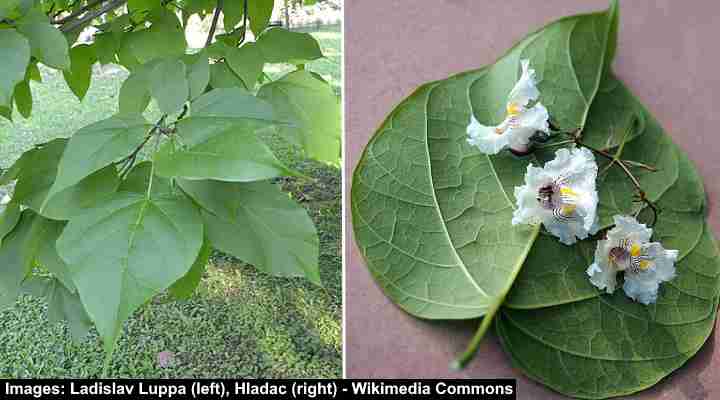
The southern catalpa is a deciduous tree known for its huge cordate leaves, which are 10” (25 cm) long. This large shade tree features an irregular broad crown, cone-like clusters of white, trumpet-shaped flowers, and long, slender, green seed pods. The tree’s interesting heart-shaped leaves have glossy upper sides and hairy undersides.
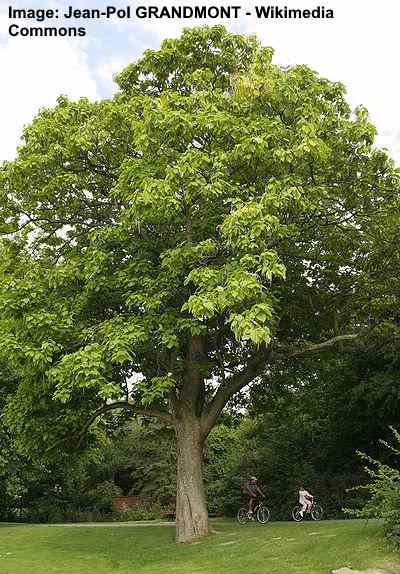
A southern catalpa tree
Ornamental features of the southern catalpa tree are its conical flowering panicles and long seed pods. These are 15” (37 cm) long and persist on the tree long after the light green leaves have dropped. Southern catalpa trees grow up to 60 ft. (18 m) tall.
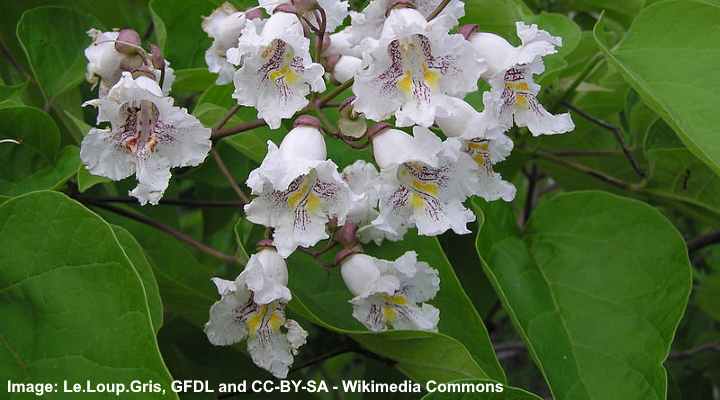
Southern catalpa flowers
The Southern catalpa tree thrives in full sun but can tolerate some shade. The versatile trees are adaptable to various soil conditions, making them useful landscaping shade trees. Their striking appearance and dense canopy make them popular choices for park and street plantings.
- USDA Hardiness Zones: 5 to 9
- Flower Color: White
- Light: Full sun to partial shade
- Mature Size: 30 to 60 ft. (9 – 18 m) tall and wide
Northern Catalpa (Catalpa speciosa)
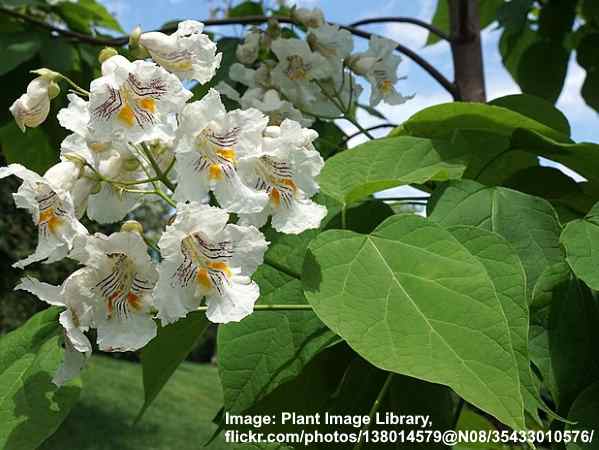
Northern catalpa leaves and flowers
The northern catalpa deciduous tree is known for its large, heart-shaped leaves that are 12” (30 cm) long. The cordate leaves have furry undersides and glossy tops. The light green leaves grow on spreading branches, creating a dense, narrow, oval crown. It blooms in late spring or early summer with clusters of funnel-shaped white flowers.
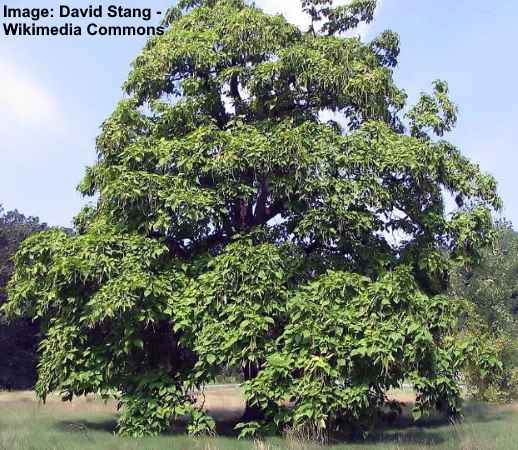
A northern catalpa tree
One of the features of northern catalpa trees is their exceedingly long brown seed pods. After flowering, the slender seed pods appear, growing 8” to 20” (20 – 50 cm) long. These dark brown capsules persist on the tree throughout winter. Unlike the southern catalpa, the northern variety has yellow fall foliage.
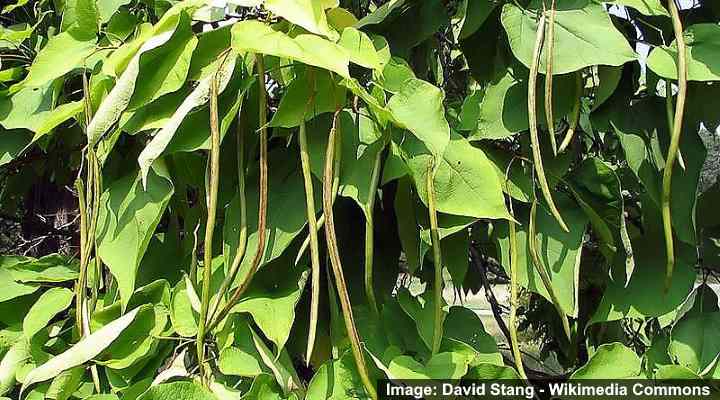
northern catalpa seed pods
Northern catalpa trees can reach heights of up to 70 feet (21 m). They are fast-growing and adapt easily to adverse conditions.
- USDA Hardiness Zones: 4 to 8
- Flower Color: White flowers 2” (5 cm) across
- Light: Full sun to partial shade
- Mature Size: 50 to 70 ft. (15 – 21 m) tall and 20 to 50 ft. (6 – 15 m) wide
Yellow Catalpa (Catalpa ovata)
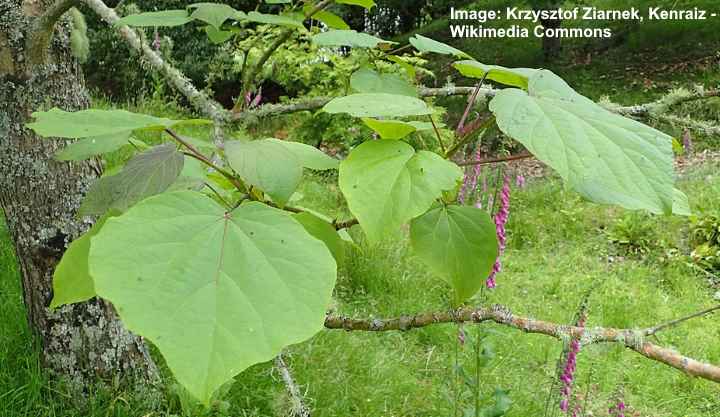
The yellow catalpa—also called Chinese catalpa—is a unique and eye-catching tree with yellowish-green, heart-shaped leaves. Ornamental features of the spring-blooming tree are its white orchid-like flowers, long, slender, stick-like seed pods, and symmetrically rounded crown. Its cup-shaped, fragrant, nectar-rich flower clusters attract pollinators like bees and butterflies.
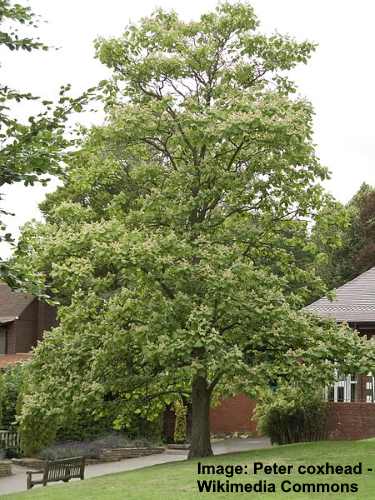
A yellow catalpa tree
Yellow catalpas are small trees that grow up to 30 ft. (9 m) tall, with a similar spread. They prefer full sun to partial shade and well-drained soils. The tree is relatively low-maintenance and can tolerate a variety of soil conditions.
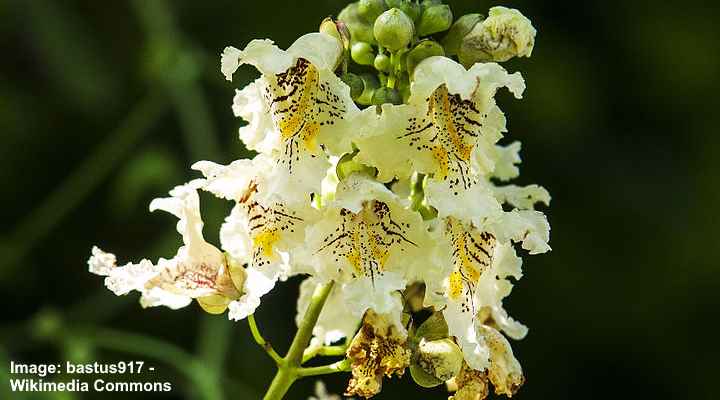
Yellow catalpa flowers
In addition to its attractive appearance, the yellow catalpa is an ideal shade tree for medium to large garden landscapes.
- USDA Hardiness Zones: 4 to 8
- Flower Color: White
- Light: Full sun to partial shade
- Mature Size: 20 to 30 ft. (6 – 9 m) tall and wide
Dove Tree / Handkerchief Tree (Davidia involucrata)

The handkerchief tree is a stunning specimen tree with heart-shaped leaves and strongly serrated edges. The tree’s most recognizable feature is large handkerchief-like, creamy-white floral bracts. Also resembling a dove’s tail, the bracts are 12” (30 cm) long in an open cup shape surrounding yellow-purple flowerheads. The cordate leaves turn red and bright orange in the fall.
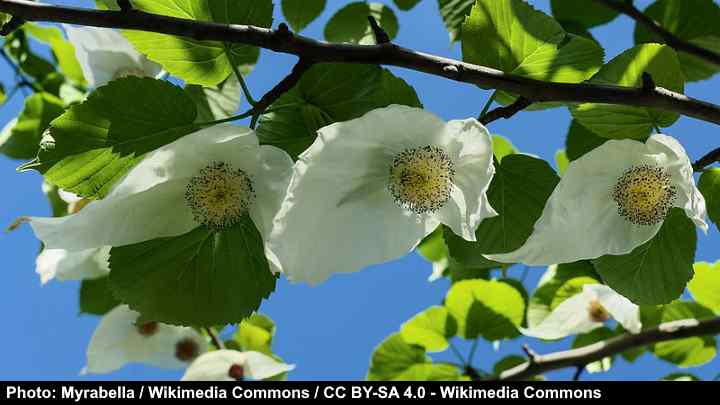
Handkerchief tree floral bracts
The handkerchief tree has a pyramidal-oval habit and grows up to 40 ft. (12 m) tall and wide. After flowering, the showy flowers give way to round, russet-colored fruits the size of golf balls. Also, its peeling cinnamon-brown bark provides winter interest.
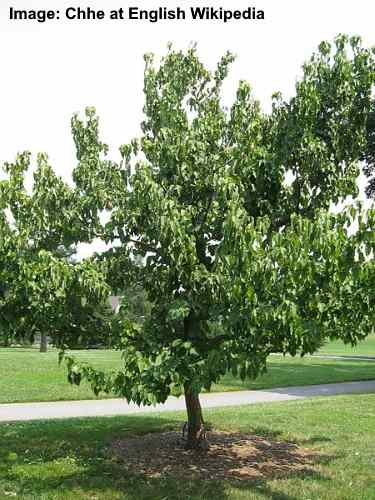
A handkerchief tree
Handkerchief trees prefer partial shade and well-drained soil. They are suited as specimen or shade trees for medium-sized landscapes or gardens. Their white dove-tail-like flowers add a unique feature to spring landscapes as they flutter in breezes.
- USDA Hardiness Zones: 6 to 8
- Flower Color: White and purple
- Light: Partial shade
- Mature Size: 20 to 40 ft. (6 – 12 m) tall and wide
Italian Alder (Alnus cordata)
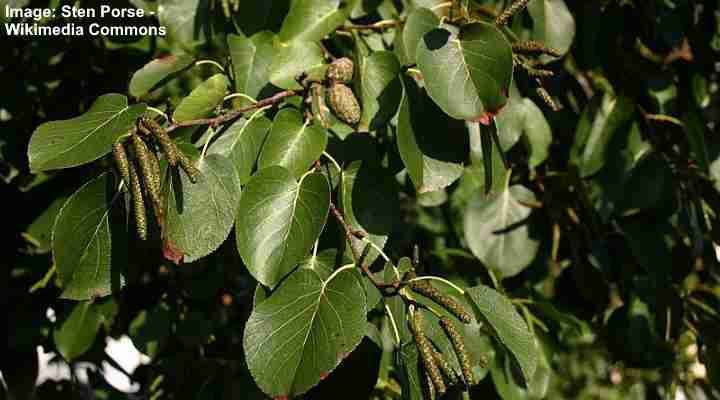
The Italian alder tree is a medium-sized tree with a pyramidal crown consisting of cordate leaves. The pointed ovate leaves have a rich, glossy green shade and measure 5” (13 cm) long. The tree blooms in spring with cylindrical clusters of yellowish-green flowers 4” (10 cm) long. These are followed by cone-like fruits.
Growing near rivers, streams, and ponds, Italian alders tend to grow as multi-stemmed shrubs. They have single, straight trunks and a conical canopy in drier landscapes. Mature trees can grow up to 80 ft. (25 m) tall. However, typical growth is 50 ft. (15 m) tall.
The trees are useful for fixing nitrogen in the soil. Italian alders also perform better in dry soils than other trees in the Alnus genus. Apart from growing as a shade tree in open landscapes, the trees are cultivated for their ability to grow in challenging growing conditions.
- USDA Hardiness Zones: 5 to 9
- Flower Color: Yellow-green dangling catkins (male trees) or cylindrical reddish clusters (female trees)
- Light: Full sun to partial shade
- Mature Size: 30 to 50 ft. (9 – 15 m) tall and 20 to 30 ft. (0.6 – 0.9 m) wide
Japanese Tree Lilac (Syringa reticulata)

The Japanese tree lilac is an attractive small tree or shrub with sharp-tipped cordate leaves. Ornamental features of the large shrub are its clusters of creamy-white flowers, musky scents, dark green, heart-shaped leaves, and reddish-brown bark with horizontal lenticels. The highly fragrant flowers attract pollinators like bees, butterflies, and hummingbirds.
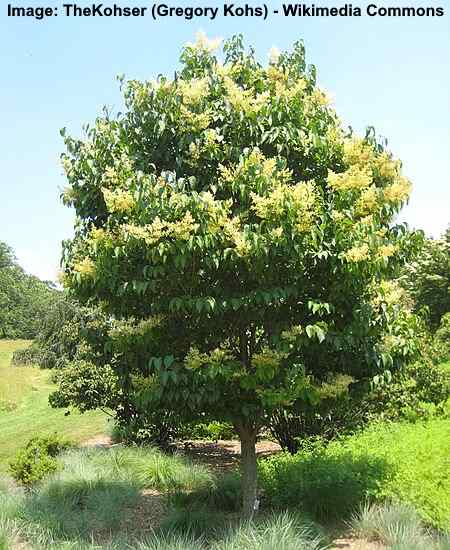
A Japanese lilac tree
The Japanese tree lilac has shrub-like growth and grows up to 30 ft. (9 m). Landscaping uses for the small tree include a specimen tree, flowering hedge, or foundation planting. Adding to its visual appeal are its exfoliating bark and dark green foliage that turns golden yellow and orange in the fall.
The Japanese tree lilac performs best in full sun but also tolerates light shade. The tree with heart-shaped leaves thrives in organically rich, well-drained soils if it has good air circulation. It’s also pollution-tolerant.
- USDA Hardiness Zones: 3 to 7
- Flower Color: Creamy-white
- Light: Full sun
- Mature Size: 20 to 30 ft. (6 – 9 m) tall and up to 20 ft. (6 m) wide
Katsura Tree (Cercidiphyllum japonicum)

The Katsura tree is a beautiful deciduous tree with broadly cordate leaves and tiny spring flowers. The tree’s heart-shaped leaves are its outstanding feature. The leaves emerge reddish-purple in spring and mature to blue-green. In the fall, the stunning foliage turns orange, gold, and red shades.
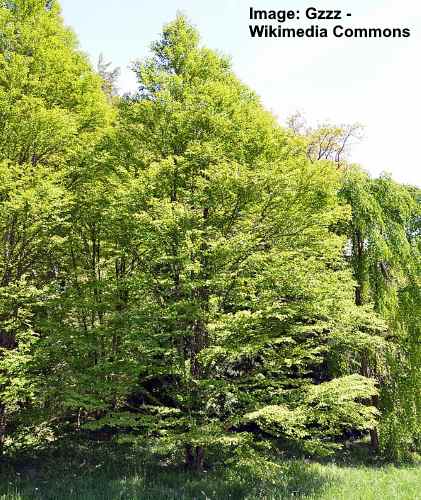
A Katsura tree
An added bonus to the beauty of the heart-shaped leaves is their sweet aromas. Additionally, the leaves emit burnt sugar, cotton candy, caramel, or cinnamon fragrances in spring and fall. This feature adds another layer of appeal to the tree, making it prized in gardens and parks.
Katsura trees grow up to 50 ft. (15 m) tall and thrive in full sun or partial shade. It grows easily in organically rich, moist soils. Its heart-shaped leaves, vibrant autumn colors, and sweet fragrance make it a standout specimen for adding beauty and interest to outdoor spaces.
- USDA Hardiness Zones: 4 to 8
- Foliage: Heart-shaped leaves that turn various shades of yellow, orange, and red in the fall
- Light: Full sun to partial shade
- Mature Size: 40 to 50 ft. (12 – 15 m) tall and a spread of 25 to 35 ft. (7 – 10 m)
Sacred Fig (Ficus religiosa)
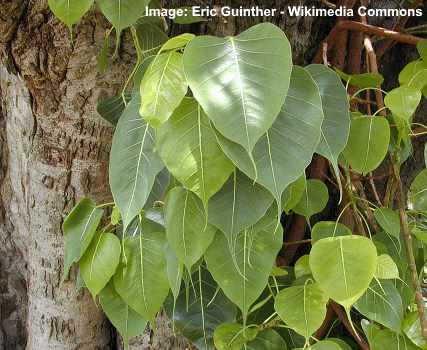
The sacred fig tree is a large, deciduous tree with distinctive heart-shaped, leathery, green leaves featuring a slender, tapered apex. The cordate leaves are 4” to 7” (10 – 18 cm) long and 5” (13 cm) wide. It has insignificant flowers growing at the base of leaf petioles.
The sacred fig tree has a wide-spreading canopy and grows up to 100 ft. (30 m) tall in ideal conditions. It thrives in tropical rainforests in its native habitat of the Indian subcontinent. The fig tree withstands flooded ground and warm, humid climates. Its most common use is as an ornamental tree in parks and gardens.
- USDA Hardiness Zones: 10 to 12
- Flower Color: Inconspicuous
- Light: Full sun
- Mature Size: 60 to 100 ft. (18 – 30 m) tall
White Mulberry (Morus alba)

The white mulberry tree is a deciduous fruit-bearing tree known for its sweet, juicy fruits and heart-shaped serrated leaves. This small tree blooms in mid-spring with clusters of greenish-white flowers followed by elongated blackberry-like fruits that ripen to dark red or purple-black. The leaves have a pointed tip, cordate base, and prominent veins.
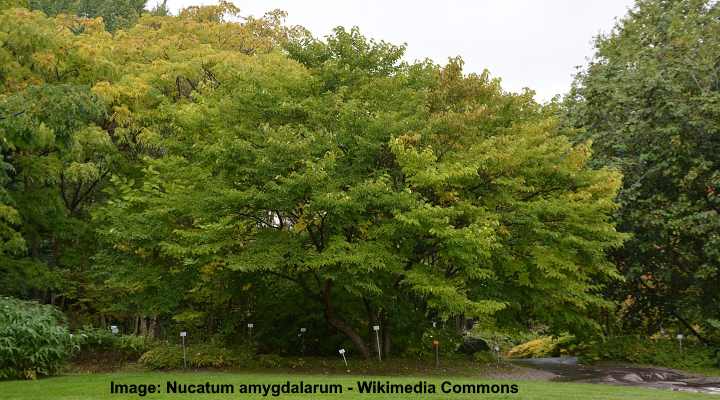
A white mulberry tree
White mulberry trees can grow up to 50 ft. (15 m) tall and have a rounded crown of spreading branches. Its eye-catching glossy green foliage turns pleasing shades of yellow in the fall. This cold-hardy tree tends to be invasive in North America, out-competing the native Morus rubra.
- USDA Hardiness Zones: 4 to 8
- Flower Color: Greenish-white
- Light: Full sun
- Mature Size: 30 to 50 ft. (9 – 15 m) tall and wide
Turkish Filbert Hazel (Corylus colurna)

The Turkish Filbert hazel tree has rounded leaves with a cordate base and doubly serrated margins. This large species of hazel has a straight trunk, clusters of pale yellowish flowers 4” (10 cm) long, and brown nuts covered in a spiny husk. The rounded leaves measure up to 6” (15 cm) long and 5” (13 cm) across.
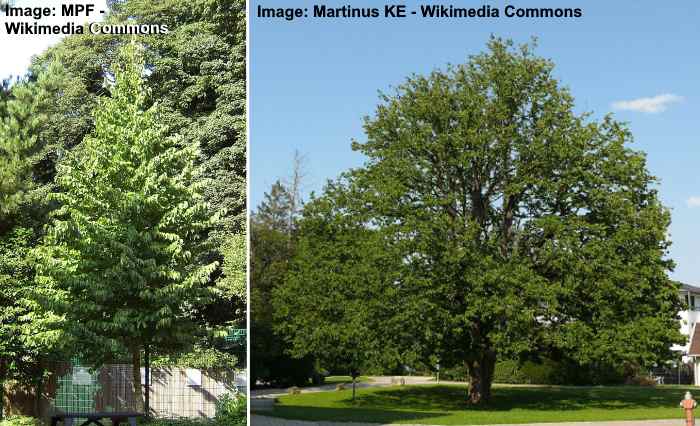
Turkish Filbert hazel tree: young and mature trees
The Turkish Filbert hazel tree is a popular ornamental tree due to its unique branching structure and attractive foliage. It grows up to 80 ft. (25 m) tall. Its bark is smooth, grayish-brown, with a thick, corky texture and deep fissures. This increases the tree’s visual interest throughout winter.
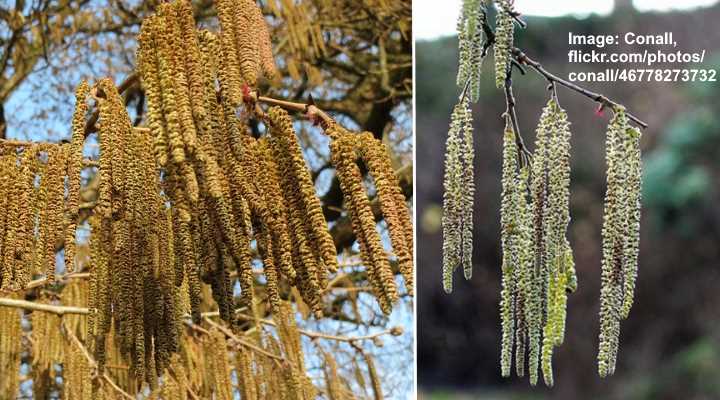
Turkish Filbert hazel male flowers (catkins)
Turkish Filbert hazel trees tolerate harsh urban conditions. This makes them useful for landscaping as shade trees in city parks, parking lots, streets, and other urban areas. Its spreading canopy provides shelter for birds, and its nuts are a food source for squirrels.
- USDA Hardiness Zones: 4 to 7
- Flower Color: Inconspicuous pale yellow
- Light: Full sun to partial shade
- Mature Size: Up to 60 ft. (18 m) tall and wide
Common Hazel (Corylus avellana)
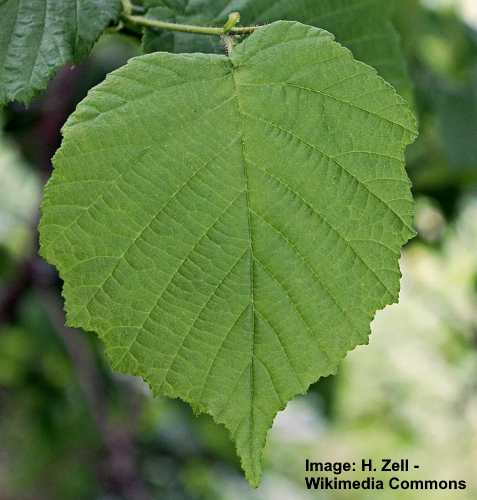
Common hazel is a deciduous shrub or small tree with rounded leaves with an extended apex, cordate base, and serrated edges. The heart-shaped leaves have a hairy texture and measure up to 4.5” (12 cm) long. It also has cylindrical male yellowish-green flower clusters and inconspicuous female reddish flowers.
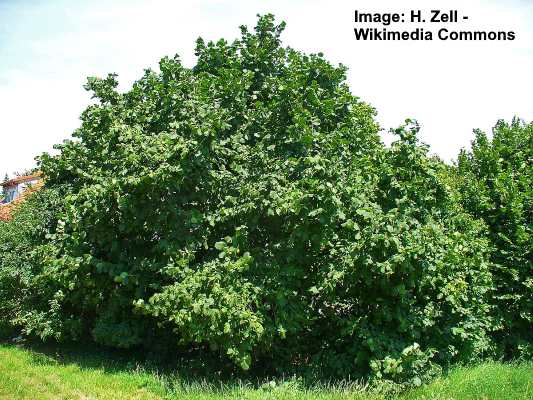
A common hazel tree
Common hazel shrub-like trees grow up to 26 ft. (8 m) tall and have a round, spreading habit. The dark green, toothed leaves create a dense canopy, helping to provide shade in landscapes. After the dangling flowers finish, the tree produces small, edible nuts—hazelnuts.
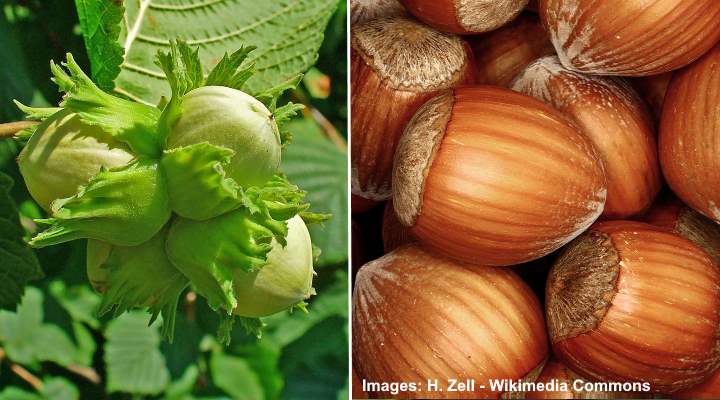
A common hazel fruit (hazelnuts)
Common hazel shrubs are cultivated for their delicious nuts. This species, Corylus avellana, is the most commonly cultivated shrub of the genus for producing hazelnuts.
- USDA Hardiness Zones: 4 to 8
- Flower Color: Pale yellow-green
- Light: Full sun to partial shade
- Mature Size: 10 to 26 ft. (3 – 8 m) tall and wide
Eastern Cottonwood (Populus deltoides)

The eastern cottonwood tree is a large deciduous native tree with triangular leaves that resemble a heart shape. The deltoid leaves are dark green and measure 5” (13 cm) long. The cordate leaves have a distinctive flat stem, causing them to flutter in the wind. Its green foliage turns golden yellow in the fall.
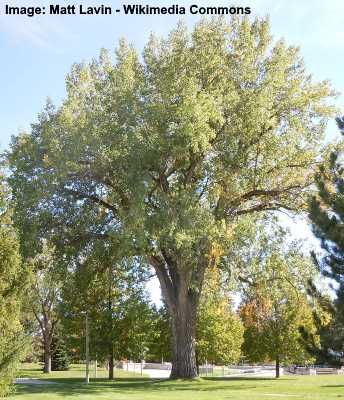
An eastern cottonwood tree
Eastern cottonwood trees bloom in spring with small, inconspicuous flowers. These give way to seed capsules that split, releasing clouds of cotton-like fluff. In some cases, the cotton-like seeds are so numerous they create a snow-like covering on the ground. The fast-growing trees have ash-gray bark and flattened ridges.
Eastern cottonwood trees thrive in moist or wet areas, like along riverbanks and floodplains. Because of the nuisance of the white fluffy seeds, it’s best to avoid planting cottonwood trees in residential areas.
- USDA Hardiness Zones: 3 to 9
- Flower Color: Inconspicuous, greenish-yellow
- Light: Full sun
- Mature Size: 50 to 80 ft. (15 – 24 m) tall and 35 to 60 ft. (11 – 18 m) wide
Heart-Leaved Paper Birch (Betula cordifolia)

As the name suggests, Betula cordifolia has leaves in the shape of a heart. This attractive deciduous tree has bronze-white or white peeling bark, cordate leaves 4.5” (12 cm) long, and dangling finger-like clusters of yellowish-green flowers. The heart-leaved paper birch also produces nutlets with papery-thin wings.
The heart-shaped leaves are simple leaves that grow alternately on brown to reddish-brown twigs. The leaf is egg-shaped with a tapering apex, finely-toothed margin, and cordate base. They have a dark green upper surface, lighter underside, and fine hairs along the vein axils.
The heart-leaved paper birch is a medium-sized tree, typically growing about 60 ft. (18 m) tall. The attractive trees thrive in moist, well-drained soils and partial shade. It commonly grows in wetland areas like streams, riverbanks, and swamps.
- USDA Hardiness Zones: 2 to 9
- Flower Color: Inconspicuous greenish catkins
- Light: Partial shade
- Mature Size: 50 to 80 ft. (15 – 24 m) tall
Related articles:
- Types of Tree Leaves – Identification Guide
- Types of Palm Fronds
- Oak Tree Leaves: Identification Guide
